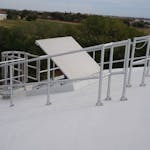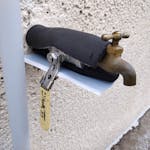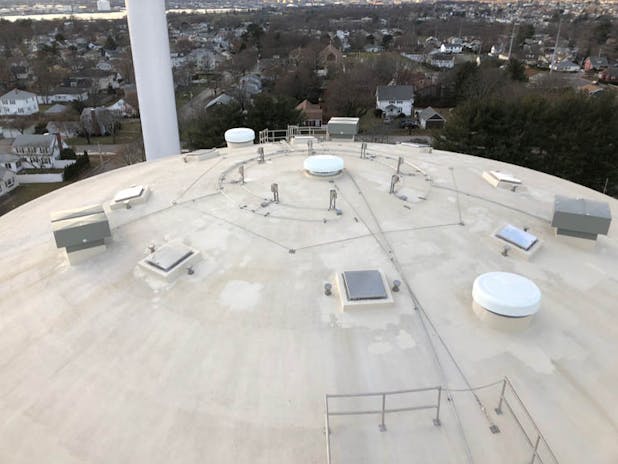Water Storage
PRELOAD’S WIRE-WOUND PRESTRESSED CONCRETE TANKS MEET WATER STORAGE NEEDS FOR THOUSANDS OF COMMUNITIES WORLDWIDE
Worldwide, communities have discovered unmatched advantages of owning Preload tanks including no routine maintenance or scheduled downtime! Preload delivers the highest-quality and most cost-effective water storage solutions, leading the wire-wound prestressed concrete tank industry in:
- A proven, low-maintenance 60-80 year life-cycle
- Flexible, customized dimensions to accommodate any pressure head or site location
- High-efficiency baffle designs for disinfection requirements
- The durability of concrete combined with a water tight embedded diaphragm
- Customized security features and accessories
- Reliability for minimal service interruptions and maintenance expenditures
Each storage tank offers a unique set of design circumstances and PRELOAD
provides near unlimited flexibility to meet the specific project demands.
Our flexible designs accommodate a variety of unique conditions and parameters,
including:
- Ground storage: PRELOAD tanks may be partially or fully buried and designed to resist hydrostatic uplift in flood-prone areas. Our team has vast expertise designing and constructing tanks in high seismic zones, soft soil conditions, extreme climates and in a wide range of sizes.
- Standpipe: PRELOAD’s Standpipe tanks have seen a long line of technical
innovations that make them an outstanding solution for communities needing a low-maintenance, reliable water storage solution. Standpipe tanks are also constructed on condensed sites, or in communities seeking a visual landmark. - Flat Roof Options: PRELOAD’s typical design incorporates an efficient, stable
concrete dome roof. While a dome roof offers the most economical cover solution, column-supported low-slope flat roof options are available.
Whatever your water storage requirements, Preload has the resources, experience, and specialty to help you meet them.





BAFFLE WALL
PRELOAD'S BAFFLE WALL DESIGNS ACHIEVE OPTIMAL DISINFECTION
Baffle Wall Specialists – At Preload, we have unmatched experience in the design and construction of internal baffle wall configurations to help our clients meet the Safe Drinking Water Act (SDWA) regulations for disinfection. We know how to configure the baffles to direct the water and efficiently achieve the required chlorine contact time (CT).
Why Use Baffle Walls – To kill or inactivate such harmful organisms as Giardia cysts and bacteria, disinfectants are added to water systems. The effectiveness of the disinfectant depends on several factors, an important one being the amount of time the water stays in contact with the disinfectant or “hydraulic residence time.” The addition of properly configured baffle walls to a tank can result in a more efficient “hydraulic residence time.”
Baffle Wall Designs – The most common baffle wall configurations are straight or a combination of c-shaped and straight. Baffle walls may be precast, cast-in-place, masonry block, or fabric.
At Preload, we are well versed in designing and constructing all varieties of baffle wall solutions. As a leading provider of effective water storage solutions since 1930, we are at the forefront of configuring water storage tanks to meet SDWA-mandated CT values. Communities nationwide are turning to Preload for today’s most advanced baffle wall tank designs.
SITE OPTIONS
NO MATTER THE WEATHER, SITE, OR SOIL CONDITIONS PRELOAD CAN BUILD A TANK AT VIRTUALLY ANY LOCATION
The Preload Team analyzes the topography, geology, and other local conditions when designing and constructing a tank. Our flexible designs can accommodate a wide range of adverse or unusual loading conditions. Prestressed concrete tanks utilize a unique concrete floor system which can accommodate substantial settlement while remaining watertight. We have constructed tanks in all types of soil conditions on all manner of foundations.
We can vary the height-to-diameter ratio and tank elevation to meet your facility’s design, hydraulic gradient, and space requirements. A detailed site layout and construction plan can be developed during the project design phase to assure the most efficient use of property and accommodate future expansion, as required.
Preload tanks can be fully buried, and can even be designed to resist hydrostatic uplift in flood-prone areas. We frequently design and construct tanks in seismic zones and on sites with differential backfill elevations.





ACCESSORIES
CUSTOMIZE YOUR TANK TO FIT YOUR NEEDS
Selecting the right accessories to meet operational needs is one of the most crucial decisions made during the design process. We know Operators will be interfacing with Preload tanks for generations which is why we offer near unlimited options for accessories focused on safety, durability and operational efficiency.
Preload knows the safety of your employees is paramount and our tank accessories are designed to comply with the most current OSHA regulations and guidelines. Unless otherwise specified, all Preload tanks are designed with OSHA compliant ingress / egress, fall protection and enclosures around commonly accessed tank features.

VENTS
Vents are the most crucial accessory of a tank. Vents allow the tank to equalize pressure during fill and draw cycles. Preload sizes each vent based on these operational parameters. Multiple material options are available. Depending on the application and location, vents can be design with security cages and frost-proof, anti-vacuum features.

HANDRAILS
Handrails are commonly installed on the tank roof to prevent falls. Handrails are designed to be OSHA compliant and commonly fabricated of aluminum, stainless steel and galvanized steel. Handrails can be designed to encompass the entire roof or isolated to hatches and other commonly accessed locations on the roof.

HATCHES
Roof hatches of any size and material can be installed to provide access for personnel and equipment. Hatches are affixed to a raised concrete curb which prohibits surface water from entering the tank. Roof hatches are commonly fabricated from aluminum, fiberglass and stainless steel.

FALL PROTECTION
Fall protection is important to life-safety and designed for OSHA compliance. Most all types of fall protection systems can be incorporated on interior and exterior ladders. Permanent safety lines and tie-off points can be installed per the owner’s requirements.

MANWAYS
Manways provide access into the tank from ground level. The number, type and manway size can be designed to the owner’s operational requirements. Manways are typically fabricated from stainless steel and can be circular or rectangular.

INSTRUMENTATION PENETRATIONS
Penetrations (sleeves) embedded into the concrete dome or tank wall can be installed to accommodate any instrument needed for tank monitoring and control. Any size sleeve can be designed and fabricated from a variety of materials such as PVC, stainless steel and ductile iron.

INTERNAL/EXTERNAL LADDERS
Exterior ladders are commonly incorporated into the tank design to provide access to the tank roof and hatches. Interior ladders provide access to the inside of the tank at hatch locations and provide a means of permanent ingress for personnel working inside the tank.

SAMPLE TAPS
Sample taps can be installed into the tank wall to provide water samples for testing or analysis. These taps can also provide a location for chlorine injection or other disinfection products. Taps can also be used for level pressure sensors.

PLATFORMS
Platforms at the top or an intermediate level can be added to access davits or other commonly used equipment. Circumferential platforms can also be installed around the tank for observation and access to equipment for wastewater process tanks.

STAIRS
Stairs may be incorporated into the tank design to provide access to the top of the tank or roof. Stairs are usually designed and installed circumferentially and supported by the tank wall. Intermediate platforms between landings are installed per OSHA guidelines. Stairs can be fabricated from aluminum, stainless steel and galvanized steel.
SECURITY
PROTECTING UNAUTHORIZED ACCESS TO WATER STORAGE
Security of a community’s water system is essential to public safety. That’s why Preload offers many features to protect your tank from unauthorized access.
- Preload offers securely fastened, stainless steel security vents protected by heavy-duty cages. We can further protect these vents with two layers of stainless steel screening. For buried tanks, we offer gooseneck vents that utilize two layers of stainless steel screening.
- Preload offers stainless steel screening to guard tank overflow exits. Our screening is heavy-duty and securely fastened. In addition, we can install a duckbill-type check valve up-line of the exit.
- Preventing unauthorized climbing on tank ladders is an especially important security feature that Preload offers. We install anti-climb plates that securely lock the ladder to stop intruders.
- We offer and install dome hatch intruder alarms that notify a central control station in the event of an attempted intrusion.
- May be protected with heavy-duty security covers equipped with padlocks.
- Preload can install intruder detection systems that integrate video and motion detection features located on and around the tank, with wireless connection to a central control station.




MIXING
ONE SOLUTION TO WATER QUALITY
Preload tanks can incorporate all variety of mixing systems to address operational and water quality considerations. Mixing is often utilized to prevent tank short-circuiting, dead zones, reduce water age, THM removal (see THM removal) and improve overall water quality. Mixing systems are commonly categorized as either passive and active mixing systems.
Active mixing systems use mechanical equipment inside the tank to drive an vane or propeller which provides mixing. Active mixing systems require a power source and periodic monitoring to verify that they are functioning or in need of repair. Generally, these systems mix the tank relatively slowly; however, they do not impact filling or drawing operations.
Passive mixings systems are built into the internal tank piping and provide mixing through the cyclical filling and emptying of the tank. Passive mixers contain no mechanical equipment, do not require a power source and require very little monitoring or maintenance. However, the valves create some minor head loss into the system and mixing only occurs during filling or drawing. Therefore, little mixing is achieved during periods of low tank usage.
THM REMOVAL
A CRITICAL PART OF SAFE DRINKING WATER
Trihalomethanes (THM’s) and other disinfection by-product have recently become increasingly regulated. Strict monitoring and treatment has been required in systems prone to THM generation.
Preload tanks are highly flexible and uniquely adaptable to nearly all types of THM monitoring and removal systems. THM removal is often achieved utilizing mixing systems in conjunction with surface aeration, agitation and forced draft ventilation. This equipment is easily supported and accommodated by the concrete tank wall and roof.
Interior aerators can be attached to the tank wall with no long-term impact to the durability and serviceability of the tank. The concrete roof is fully capable of supporting the weight of mechanical blower and ventilation equipment.
Further, should an existing tank require a THM removal system retrofit, Preload has substantial experience in the design and installation of these retrofits.



